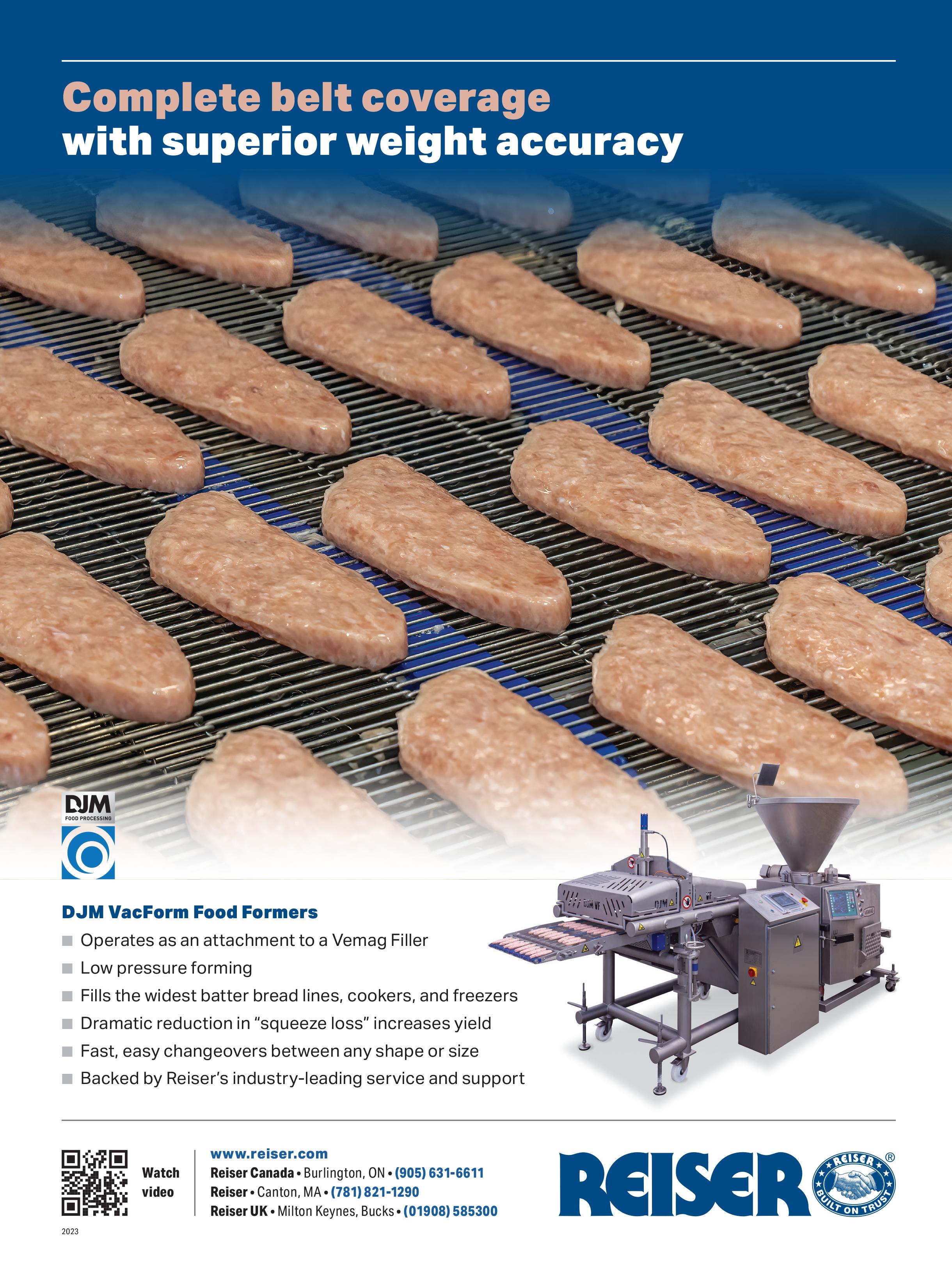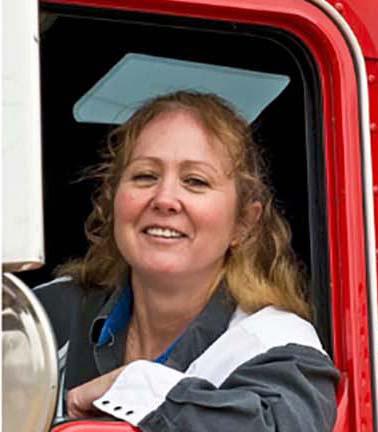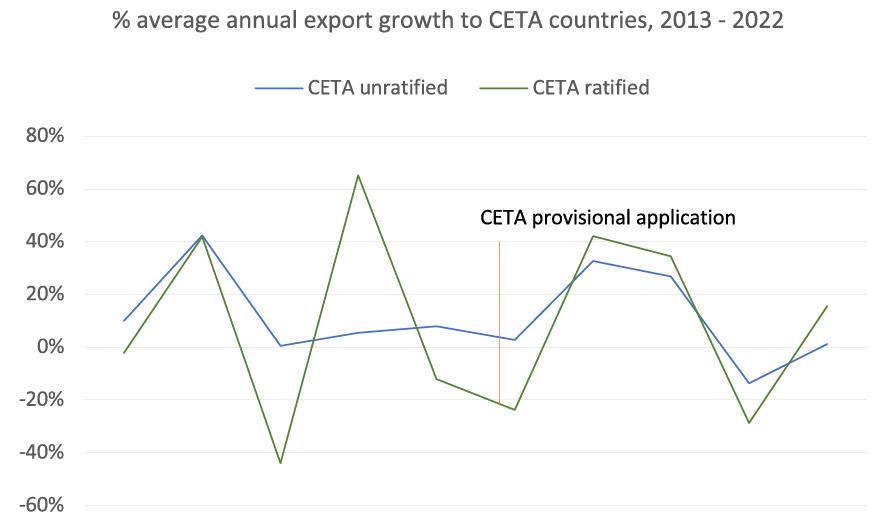
TRADE WITH THE U.S. PROVIDES A SAFE HARBOUR DURING THE PANDEMIC BCRC Announces $2 Million in Funding for 12 Beef Research Projects What We Heard Report: Agricultural Labour Strategy NAMI: Meat and Poultry Industry Facing Headwinds Rise in Farm-to-Fork Buying Has Been Fueled by the Pandemic How to Call a Fight with No Winner: Canada’s Farmland vs. Urban Sprawls meatbusinesspro.com $7.99 THE BEEF, PORK & POULTRY INDUSTRY DIGITAL MAGAZINE June 2023
https://www.yesgroup.ca

2 MEATBUSINESSPRO June 2023 meatbusinesspro.com
JUNE 2023
5 6 10 12 14
Animal Health Canada Announces Updated CLT Program Trade with The U.S. Provides a Safe Harbour During the Pandemic BCRC Announces $2 Million in Funding for 12 Beef Research Projects
What We Heard Report: Agricultural Labour Strategy
16 18 20 22
MPO Celebrates 10 Years of Ontario’s Finest Butchers
NAMI: Meat and Poultry Industry Facing Headwinds Rise in Farm-to-Fork Buying Has Been Fueled by the Pandemic FCC Supports Customers in the Hog Sector
How to Call a Fight with No Winner: Canada’s Farmland vs. Urban Sprawl


https://www.yesgroup.ca
PUBLISHER
Ray Blumenfeld ray@meatbusiness.ca
MANAGING EDITOR
Scott Taylor publishing@meatbusiness.ca
DIGITAL MEDIA EDITOR
Cam Patterson cam@meatbusiness.ca
CONTRIBUTING WRITERS
Roberts,
CREATIVE DIRECTOR Patrick Cairns

Meat
ANIMAL HEALTH CANADA ANNOUNCES UPDATED CLT PROGRAM

Animal Health Canada has announced a significant update to its Canadian Livestock Transport (CLT) certification program, a comprehensive training course for livestock and poultry transporters, shippers and receivers.


Enrolment is open now on its newly launched e-learning platform at campus. animalhealthcanada.ca.
Recognized across Canada and the United States, CLT is an easily accessible, standardized online program offering humane animal transportation certification. The update, based on the most recent regulations, revamped the core training materials to make the training program more engaging and userfriendly.
CO MMUNICATIONS W EST IN C
We Communications West Inc. 106-530 Kenaston Boulevard Winnipeg, MB, Canada R3N 1Z4 Phone: 204.985.9502 Fax: 204.582.9800
Toll Free: 1.800.344.7055
E-mail: publishing@meatbusiness.ca
Website: www.meatbusinesspro.com
Meat Business Pro subscriptions are available for $28.00/year or $46.00/two years and includes the annual Buyers Guide issue.
©2020 We Communications West Inc. All rights reserved.
The contents of this publication may not be reproduced by any means in whole or in part, without prior written consent from the publisher. Printed in Canada. ISSN 1715-6726
Simultaneously, AHC is launching an awareness campaign named ‘Better Safer Canadian’. The campaign includes a new wordmark in English, French and Spanish, video and other resources aimed at stakeholders in animal transport, underlining the importance of CLT certification.

“Handling and transporting livestock is one tough job,” said Colleen McElwain, Executive Director, Animal Health Canada. “We believe the CLT certification program is the best choice in training, benefiting everyone in the industry from farmers to transporters to consumers.”

Livestock handling and transporting training is not only essential, but also mandated by the Canadian Food Inspection Agency (CFIA) through Part XII of the Health of Animals Regulations.
The Better Safer Canadian campaign focuses on three key messages:
1. The new CLT program delivers a better multimedia experience accessible 24-7. You can get certified using their smartphone, tablet or computer.
2. Training is also key to safety and CLT training helps both you and the animals.
3. CLT is the only program based on Canadian regulations and is valid in the US. Additionally, the new e-learning platform now features a validation tool to verify CLT certification.
ABOUT ANIMAL HEALTH CANADA
Animal Health Canada is the only national organization that brings together industry, federal, provincial, and territorial partners to provide collaborative guidance on a cohesive, functional, and responsive farmed animal health and welfare system in Canada. For more information, visit https:// animalhealthcanada.ca
5 meatbusinesspro.com June 2023 MEATBUSINESSPRO
June 2023 Volume 24 Number 6
Business Pro is published 12 times a year by We Communications West Inc
THE BEEF, PORK & POULTRY INDUSTRY DIGITAL MAGAZINE
Martha
James Chaarani, Taylor Brown, Scott Taylor, Jack Roberts
TRADE WITH THE U.S. PROVIDES A SAFE HARBOUR DURING THE PANDEMIC
 By Martha Roberts, Economics Editor, FCC
By Martha Roberts, Economics Editor, FCC
On the occasion of the U.K. joining the Comprehensive and Progressive Trans-Pacific Partnership (CPTPP), we’re looking at Canadian export performance in key trading blocs with whom we have agreements. The CPTPP welcomes Britain alongside 11 founding members, including Australia, Brunei, Canada, Chile, Japan, Malaysia, Mexico, Peru, New Zealand, Singapore, and Vietnam. It’s one of several multilateral agreements that allow Canadian exporters preferential access to major markets. The Comprehensive Economic and Trade Agreement (CETA) with the European Union is the other major bloc selected here, and both are compared to our export performance over the last 10 years of trade with the U.S., China and the U.K.
THE CPTPP: WHAT HAVE YOU DONE FOR ME LATELY?
Agreements eliminate many, if not most, tariffs, which the CPTPP did for a region comprising the world’s leading economic growth region – the motivation behind the years of work necessary to get to the point of ratification. It’s an important region for our exporters: Of all current members, Japan, Mexico and Vietnam are Canada’s largest markets for several food products.
However, in the four years and two months since the agreement became active, the benefit to Canadian exports of agricultural commodities and food products to the region has wavered (Figure 1). Compared to the five years before the agreement, Canada’s food trade appears as susceptible to volatility, as shown in the average annual growth (AAG) rate over the 9 years. The agreement seems to have made a difference immediately following ratification, although that trend quickly ended when the global pandemic struck. The AAG rate for 2014 – 2018 was 3.5% compared to the 2.8% rate between 2019 and 2022.
Trade agreements such as the CPTPP ease the normal export costs to foreign markets. Tariffs, a kind of tax applied at borders, drive up the cost of the exported good, making it less competitive with domestically produced substitutes in the foreign retail markets.




6 MEATBUSINESSPRO June 2023 meatbusinesspro.com
THE BEFORE AND AFTER STORIES OF THE CPTPP: BIG SWINGS CHARACTERIZE BOTH PERIODS
The volatility that characterizes our export performance under the CPTPP is like the swings visible in the periods directly before and after CETA came into force (Figure 2). The introduction of this agreement has helped smooth out the swings somewhat, although it’s difficult to measure the exact benefits outright.

Of the 27 individual countries signed to CETA, 17 have ratified the agreement. But ratification status hasn’t made much difference to the pace of growth of EU imports to date. In both cases, the period postenforcement featured slowed AAG rates. Unratified

markets had a rate of 13.3% each year before and a rate of 9.4% after. Ratified markets had a rate of 9.8% each year before the agreement came into force and 7.9% each year after.
RATIFICATION AMPLIFIES GROWTH TRENDS


However, the two periods are hard to compare as the pandemic also took a bite out of Canadian exports of agricultural commodities and food products here. But, unlike with CPTPP countries, the big nosedive noticeable in 2020 reversed in 2021, with both ratified and unratified countries increasing their imports yearover-year (YoY).
Continued on page 8
7 meatbusinesspro.com June 2023 MEATBUSINESSPRO
CETA: RATIFIED EUROPEAN EXPORT MARKETS MAY YET OFFER GREATER BENEFIT
VEMAG REPLACEMENT PARTS https://www.dhenryandsons.com
We’ll see at the end of this year if the trend from 2022’s faster growth of ratified countries continues. It’s hardly guaranteed. The Russia-Ukraine war has caused upheaval in commodity markets and supply chains and has helped to realign trade partners along emerging or strengthened geopolitical lines.
WHAT TO EXPECT FROM THE U.K.
The U.S. remains Canada’s largest and most important export market. The strength and history of the relationship between the two countries is evident in the relative stability of our exports there over the same 10year period (2013 – 2022) (Figure 3). The introduction of the Canada-U.S.-Mexico Agreement (CUSMA) in July 2020 updated the 26-year-old North American Free Trade Agreement (NAFTA) with terms and mechanisms more suited to the current global trade landscape. It, too, had an immediate effect, but unlike the CPTPP and CETA, it was brought into force during the pandemic. Underscoring the value of our U.S. trade relations, Canada’s AAG of food exports to the U.S. was 2.7% in 2018 and 2019 and 14.5% in 2021 and 2022.
U.S. TRADE BRINGS STABILITY TO CANADIAN AGRIFOOD EXPORTS

Our exports to China are a study in contrast. Between 2013 and 2018, Canadian export growth climbed at an AAG rate of 17.1%. In 2018, diplomatic tensions led to a Chinese boycott of some of Canada’s exports, a trend that was then reversed in 2019 only to be cut short by the pandemic. The U.K. also shows volatility in the AAG rate and the same dampening effect of the pandemic, which lasted to the end of 2022. But their growth in imports of Canadian agricultural commodities and food products continues to be positive.



BOTTOM LINE
Diversification away from the U.S. is good risk management for Canada’s food sectors and individual businesses. While that won’t be easy, the availability of numerous trade agreements with other key markets will help. However, in our trade with major trading blocs, the disruption of the pandemic continues to be felt, with non-U.S. markets showing a great deal more volatility in their imports of Canadian goods both before the agreements came into effect and after. We have yet to determine if that’s a feature of 2023 markets or when it may end.
8 MEATBUSINESSPRO June 2023 meatbusinesspro.com
funding will be leveraged with over $4 million in Twelve

THE BEST DEFENSE IS A STRONG OFFENSE
PROMOTING THE HEALTH BENEFITS OF MEAT AND POULTRY
Red meat is often wrongly portrayed as being unhealthy. Even chicken has been getting attacked by
liver, 625 grams of cooked beef or an astounding 2.4 kg of
their meat and poultry purchases. Perceptions may reality but truth trumps misinformation. Parents and other consumers want what is best for their health and that of their families. They are also aware that a lot of false information is out there and as such, are open to scientific facts that can correct their misconceptions.
BCRC ANNOUNCES $2 MILLION IN FUNDING FOR 12 BEEF RESEARCH PROJECTS
Iron found in vegetables is harder to absorb than the iron found in meat as it is attached to fibre which inhibits its absorption.
2. Eat Meat for a Healthier Brain!
Twelve research projects have been awarded a total of $2 million in funding by the Beef Cattle Research Council (BCRC) through the 2022/2023 annual call. Through these projects, the $2 million of industry funding will be leveraged with over $4 million in matching funding through government and industry partners.



This provides an opportunity for retail meat departments to implement an instore ‘Healthy Meat Facts’ nutritional campaign to set the record straight and convince their customers that meat and poultry are actually good for one’s health and that they should increase rather than decrease their purchases of it. The campaign outlined below can have a direct impact on sales:
Start by displaying instore posters promoting the nutritional value of meat. They should be innovative, eye catching and be designed to specifically contradict any meat myths. The comments should all be literature based quoting research papers or MDs for maximum effect. Various posters should be made - each with a brief but powerful message covering one theme.
As an Alberta beef producer, including a backgrounding feedlot and cow-calf operation, BCRC Chair Craig Lehr sees first-hand how applied research improves the productivity and profitability of Canadian beef production.

Posters can convey the following healthy meat fact messages:
Being deficient in the micronutrients found in meat have been linked with low IQ, autism, depression and dementia says Dr. Charlotte Neumann, a paediatrician at the University of California, as quoted in the article ‘Brain food- clever eating’. Zinc is crucial for learning and memory. Vitamin B12 preserves the sheaths that protect nerves.
3. Boost Your Immunity with Meat!
The investment in these projects will ensure that research is being done in areas that directly impact the Canadian Beef Industry and the priorities laid out in the Five-Year Canadian Beef Research and Technology Transfer Strategy.
Due to its antioxidant powers, zinc is involved in creating
1. Let’s IRON out the Truth on Meat!
“You would need to eat a massive amount of spinach to equal (the iron content) in a steak,” says Christopher Golden, an ecologist and epidemiologist at Harvard University in Cambridge, Massachusetts. (As quoted by nature.com in the article ‘Brain food- clever eating’.)
For a woman to receive her recommended daily intake of 18 mg of iron, she would need just 300 grams of cooked bovine
“We are able to leverage producer dollars from the Canadian Beef Cattle Check-Off to support research that truly matters to the day-to-day management of our herds,” says Lehr. “This is important work. The BCRC not only funds the research but develops practical resources to support producers in making informed decisions to improve profitability, keep Canadian beef competitive and continue our ability to operate with a social license."
acid, vitamin B12 and vitamin B6. They are all found in meat. The line that ‘the best defense is a good offense’ does not only apply to sports. It also applies to countering negative meat health myths. Implementing an instore ‘Healthy Meat Facts’ nutritional campaign to set the record straight on meat and poultry. It is a good way to go on the offensive by using education your customers and increasing your sales..
https://www.mmequip.com

Ronnie P. Cons is CEO of C&C Packing Inc., a leading Canadian distributor of meat and poultry. He can be reached at RCons@CCpacking.com.
“Research matters. It moves the needle on best practices used across the industry, from animal health and productivity to nutrition, forage and grazing management, soil health, and the list goes on,” says Ron Stevenson, BCRC vice chair and Ontario cow-calf producer, who values industry-funded research not only as producer, but also through his experiences working in the veterinary industry. The investment in these projects will lead to outcomes that have an impact, providing tools for farmers and ranchers to continuously improve.”
10 MEATBUSINESSPRO June 2023 meatbusinesspro.com
22 CANADIAN MEAT BUSINESS September/October 2017 meatbusiness.ca
• Testing new forage varieties to improve production and reduce our carbon hoofprint. Project Lead: Dr. Ribeiro, University of Saskatchewan
NSF INTERNATIONAL FOCUSES ON CANADIAN FOOD INDUSTRY WITH NEW WEBSITE FOR SERVICES IN CANADA
• Forage for climate action – Can grazing perennial forages improve environmental sustainability and animal health? Project Lead: Dr. Poudel, Agriculture & Agri- Food Canada, Lethbridge
PROJECTS FUNDED UNDER THE 2022/2023
BCRC CALL INCLUDE:
• The known unknowns – Pulling back the cover on macrolide resistance in feedlots. Project Lead: Dr. Ruzzini, University of Saskatchewan

NSF International in Canada recently launched a new website - www.nsfcanada.ca - to give Canada’s growing and complex food and beverage industry easy access to the global public health organization’s expertise and services in Canada. The website combines information on the depth, experience and capabilities of the NSF International Canadian office with access to NSF International’s global services dedicated to food safety and quality.
• Does supplementing pregnant cows with protein during winter grazing improve calf health? Project Lead: Dr. Malmuthuge, Agriculture & Agri-Food Canada, Lethbridge
• Can genomic tests identify the infectious causes of reproductive losses better than traditional diagnostics? Project Lead: Dr. Huang, Prairie Diagnostic Services Inc.

Evolving regulations across countries and increasing complexities associated with a globalized food supply network present challenges for NSF International clients in Canada and around the world. The new Canadian website offers expertise and services to help companies navigate these challenges, including certification and auditing, consulting, technical services, training and education, food and label compliance, packaging, and product and process development.
• Boosting calf immunity with early-life management. Project Leads: Dr. Malmuthuge, Agriculture & Agri- Food Canada, Lethbridge and Dr. Erickson, University of Saskatchewan

NSF International’s Canadian website provides information on the following services:






• Turning lemons into lemonade and cattle hide into snacks. Project Leads: Dr. Bruce and Dr. Roy, University of Alberta
• Cracking the code on early life management of crossbred dairy-beef calves. Project Lead: Dr. Steele, University of Guelph
Certification & auditing: Third-party food safety audits and certifications, which are integral components of supplier selection and regulatory compliance. Accurate audits are the first step toward successful verification of a company’s food safety system, providing improved brand protection and customer confidence. Certifications and audits are available for animal and produce in the agriculture industry, GFSI certification and management system registration.
• Can natural malate production in forages reduce methane emissions in grazing cattle? Project Lead: Dr. Block, Agriculture & Agri- Food Canada, Lacombe
• Burn baby burn – Can prescribed fire be a tool for pasture rejuvenation and improved soil health? Project Lead: Dr. Bainard, Agriculture & Agri- Food Canada, Agassiz
Consulting: A full-service team approach providing technical resources, expertise and insight for a wide range of food safety and quality services. NSF International provides finished product inspection testing for food, packaging and non-food testing for rapid analysis and insight to protect the brand, technical support services from on-site temporary or permanent technical staffing placements, and various types of consulting.

Technical services: A one-stop solution for food product compliance and formulation, from concept to finished product, including food and label compliance, packaging, product and process development, and shelf-life and product evaluation.

• Maximizing pasture’s grazing potential by sod-seeding alfalfa mixes. Project Lead: Dr. Lardner, University of Saskatchewan
Training and education: Training for the global food and beverage industry across the supply chain as an
• Understanding rest-recovery and grazing management for native prairie to improve grassland and animal productivity. Project Lead: Dr. Kelln, University of Saskatchewan
Global public health organization showcases services for Canada’s growing and fast-changing food industry
accredited International Association for Continuing Education and Training (IACET) site. Topics include HACCP, food safety and quality, GFSI benchmarked standards, regulations (including FSMA), food science, food packaging, food microbiology and ISO standards. Training modalities include eLearning, on-site, customized and open enrolment. Additionally, the website includes information about management system registrations for the food, automotive, environmental, information security, medical devices, aerospace and chemical industries, as well as for Ontario drinking water programs.
The BCRC is Canada’s national industry-led funding agency for beef, cattle and forage research. The BCRC’s mandate is to determine research and development priorities for the Canadian beef cattle industry and to administer Canadian Beef Cattle Check-Off funds allocated to research. A division of the Canadian Cattle Association, the BCRC is directed by a committee of 15 beef producers from across the country. The BCRC is funded in part through a portion of the Canadian Beef Cattle Check-Off which is then leveraged with government and industry partner funding. For more information, visit https://www.beefresearch.ca/
Visit the new Canadian website at www.nsfcanada.ca to review the food safety services capabilities video, find a list of Canadian food experts, learn about upcoming events and global news releases, submit a question or read an FAQ.
https://www.yesgroup.

11 meatbusinesspro.com June 2023 MEATBUSINESSPRO September/October 2017 CANADIAN MEAT BUSINESS 23 meatbusiness.ca YesGroup_CanadianMeatBusiness-Qtr-pg.pdf 1 2014-05-16 1:20:17 PM
WHAT WE HEARD REPORT: AGRICULTURAL LABOUR STRATEGY

The Canadian Federation of Agriculture and its partners


The Canadian Agricultural Human Resources Council (CAHRC) and Food and Beverage Canada (FBC) are pleased to see Agriculture and Agri-Food Canada’s (AAFC) What We Heard Report, which details feedback received by the Department during consultations on the development of a National Agricultural Labour Strategy. Work on this strategy is a key item in the Mandate Letter of the Honourable Marie-Claude Bibeau, Minister of Agriculture and Agri-Food.
As part of AAFC’s consultation process, the Canadian Federation of Agriculture (CFA), the Canadian Agricultural Human Resource Council (CAHRC), and Food and Beverage Canada (FBC-ABC) provided an interim report on the development of an industryled National Workforce Strategic Framework for Agriculture and Food & Beverage Manufacturing. This interim report included the signatures of 34 industry organizations as well. The input from this is wellreflected in the What We Heard Report, demonstrating the collaboration between the two initiatives.
We appreciate the commitment to collaborative and sustained engagement from AAFC and the Minister that will ensure both strategies remain aligned on wanting to take complementary and collaborative action on short, medium and long-term solutions to address labour shortages and systemic workforce challenges.
The Canadian Federation of Agriculture (CFA), the Canadian Agricultural Human Resource Council (CAHRC), and Food and Beverage Canada (FBC-ABC) have been championing development of an industryled National Workforce Strategic Framework for Agriculture and Food & Beverage Manufacturing since 2021, with funding from the Government of Canada’s Future Skills Centre. To date there have been more than 100 industry participants involved in this work through advisory committees, working groups and broader engagement. The National Workforce Strategic Plan seeks to complement the efforts of the Government of Canada, including the development of a National Agricultural Labour Strategy.

12 MEATBUSINESSPRO June 2023 meatbusinesspro.com
ABOUT THE CANADIAN AGRICULTURAL HUMAN RESOURCE COUNCIL
The Canadian Agricultural Human Resource Council works with industry leaders, governments and educational stakeholders to research, develop and communicate solutions to the challenges in employment and skills development in primary agriculture.

ABOUT THE CANADIAN FEDERATION OF AGRICULTURE

The Canadian Federation of Agriculture (CFA) was formed in 1935 as a unified voice to speak on behalf of Canadian farmers. CFA’s work continues today as a farmer-funded, national umbrella organization comprising of provincial general farm organizations and national and interprovincial commodity groups, representing producers of all commodities, who operate farms of all sizes. Through its members, CFA represents approximately 190,000 Canadian farm families from coast to coast to coast. CFA promotes the interests of Canadian agriculture producers to ensure the continued development of a trusted, sustainable, and vibrant agriculture sector in Canada.

ABOUT FOOD AND BEVERAGE CANADA
Food and Beverage Canada (FBC-ABC) is the national industry association representing Canada’s domestic food and beverage manufacturers. Its members include Canada’s provincial and regional food and beverage manufacturing associations as well as leading Canadian food and beverage companies. FBC-ABC advances a competitive business environment that enables growth and sustainability through knowledge sharing, consultation, business-led solutions and proactive advocacy. Across Canada there are almost 8,000 food and beverage manufacturing establishments employing almost 300,000 workers.

13 meatbusinesspro.com June 2023 MEATBUSINESSPRO
MPO CELEBRATES 10 YEARS OF ONTARIO’S FINEST BUTCHERS


Ontario’s Finest Butcher Competition, a prestigious event that has elevated the art of butchery and showcased the remarkable skills of Ontario’s artisans, is proudly celebrating its 10th anniversary. This milestone event honours the craftsmanship, innovation, and local food culture that make Ontario’s Finest Butcher Competition truly exceptional.
Franco Naccarato, Executive Director of Meat & Poultry Ontario (MPO), expressed his excitement and gratitude for this significant achievement, saying, "Over the past decade, Ontario’s Finest Butcher Competition has become a symbol of excellence in the industry. It has been a privilege to witness the dedication and talent of our local butchers, and we are thrilled to celebrate this milestone with them."
A vital element in the success of the competition has been the unwavering support of Halenda’s Meats, Mississauga, as the host of the elimination round. Their commitment has made the competition an unforgettable experience for competitors and spectators alike.
In 2023, Ontario’s Finest Butcher Competition is set to embark on an exciting new chapter, promising more thrills and accessibility for all. The elimination round has found a new home at Handtmann Canada in Waterloo, introducing fresh competition rules including; competitors will now be tested on their core competencies, the addition of veal as a protein option in the elimination round, and the finale has been extended to 45 minutes allowing our talented butchers more room to showcase their creativity and expertise. The prizing package for finalists and winners has been enhanced to offer unparalleled rewards.
Franco Naccarato emphasized the significance of these changes, stating, "The 2023 edition of Ontario’s Finest Butcher Competition marks a turning point in our



journey. We are excited to introduce new elements that will challenge our participants and captivate our audience. It’s an opportunity for our butchers to truly shine and push the boundaries of their craft."
Registration for Ontario’s Finest Butcher Competition is now open. The Elimination Round will take place on Monday, September 11 at Handtmann Canada, where competitors will showcase their technical knowledge and knife skills. The top three contenders will advance to the finals, which will be held on October 21 at the Meating Place Conference in Muskoka, in front of a live audience. The winner will be announced on October 21 at the highly anticipated Meat & Poultry Ontario’s Red Carpet Gala.

For more information and to register, visit www. meatpoultryon.ca or contact technical@meatpoutlryon.ca
Follow us on Instagram @ontariomeatpoultry for updates, behind-the-scenes content, and exclusive highlights of the competition.
ABOUT MPO
Meat & Poultry Ontario (MPO) is the representative voice of Ontario’s meat industry. Our members are independent businesses proud to serve the communities they live and work in. The association is comprised of meat and poultry processors, wholesalers, and retailers; industry suppliers; and not-for profit organizations that support MPO’s objectives.
Ontario’s meat and poultry sector employs 25% of Ontario’s food and beverage processing industry — the single largest manufacturing employer in Ontario — and generates $11.2 billion of the province’s $45 billion food and beverage processing industry revenue.
14 MEATBUSINESSPRO June 2023 meatbusinesspro.com
https://www.beaconmetals.com

NAMI: MEAT AND POULTRY INDUSTRY FACING HEADWINDS




At a recent hearing of the House Agriculture Committee’s Subcommittee on Livestock, Dairy and Poultry, Bryan Burns, Vice President and Associate General Counsel of the North American Meat Institute (NAMI) said the meat and poultry industry was facing economic headwinds, challenges in the courts and hurdles with new regulations but remains resilient with record production.
“I want to emphasize that the industry is incredibly resilient, despite claims to the contrary,” said Burns. “Against challenges such as COVID, supply chain disruptions, labor availability, and the impact of drought, beef production set new records for four consecutive years from 2019 through 2022. Pork production has seen its highest four-year totals over the same period.”

Prior to working for the Meat Institute, Burns spent 20 years in the industry, first as counsel at one of the nation's largest meat and poultry processors and later as General Counsel and VP of Environment, Health and Safety at a smaller poultry company.
The hearing entitled, “A Review of Animal Agriculture Stakeholder Priorities,” was chaired by Subcommittee Chairman Tracey Mann (R-Kan.) and Subcommittee Ranking Member, Representative Jim Costa (D-Cal.).
At the hearing, Burns conveyed the priorities of meat and poultry packers and processors which included:
PROPOSITION 12:
“It will embolden anti-animal ag groups to pursue burdensome laws elsewhere and will open the door to chaos in interstate commerce through state-by-state trade barriers, not just for meat and poultry products, but for any products not meeting the standards set by another state,” said Burns. “Industry needs certainty. But any federal solution requires careful drafting to ensure it is legally sufficient yet not vulnerable to challenges in the courts.”

ADMINISTRATION’S PROPOSED RULES UNDER THE PACKER AND STOCKYARDS ACT:
“The Administration claims the proposals are needed because the injury to competition standard is an insurmountable bar for plaintiffs and eliminating it will help rein in the big companies,” said Burns. “However, the small, family owned poultry company I once worked for suffered a $14.5 million verdict in a Packers and Stockyards case decided under the injury to competition standard, an amount large enough to drive it to the verge of bankruptcy. The result was that the company was acquired by an owner outside the United States.”

16 MEATBUSINESSPRO June 2023 meatbusinesspro.com
LABOR SHORTAGES:
DF: I don’t think being on the island has really impacted us negatively one way or the other. We’ve traveled a lot, met a lot of other farmers and livestock producers in other parts of Canada, and we all seem to have the same issues and same concerns.
CMB: I understand that your farm was the first in Atlantic Canada to be involved in the TESA program.
DF: Yes, I think we were the first farm east of Ontario as far as I understand.
“We are pleased that House Agriculture Committee Chairman G.T. Thompson (R-Penn.) plans to establish an agricultural workforce working group within the House Agriculture Committee,” said Burns. “Currently, meat packing and processing facilities are not eligible to employ workers under the H-2A visa program for agricultural guest workers -- even though we are the essential harvest stage of the livestock industry. We urge the working group to consider the workforce needs of our industry as it deliberates. We are essential to the food supply. We would welcome the opportunity to be part of the discussions so that a solution can be found that works for all of agriculture.”
I’m not sure why the eastern associations wouldn’t have previously nominated anybody because there are many farms here on PEI doing every bit as much as we are as to attain a high level of sustainability. Anyway, we were very surprised when the PEI Cattleman’s Association nominated our farm.
CMB: And then you were attending the Canadian Beef conference in Calgary and you won.
REAUTHORIZATION OF THE LIVESTOCK MANDATORY REPORTING (LMR) ACT:
“Since 2020, Congress has extended LMR’s five-year authorization annually in appropriations legislation. NAMI continues to support, a clean, five-year reauthorization of LMR uncoupled from the Farm Bill.”
DF: Yeah! That was a very nice moment for us. But I don’t like to use the word win actually. However, being recognized for our commitment was a real honour. If you want to know the truth, it was a pretty humbling experience. As I said to CBC when they phoned me after the conference, I was just floored, really couldn’t believe it.
The most recent data from the U.S. Census Bureau shows meat and poultry processing is a $266.99 billion industry employing 526,849 people directly and supporting many more jobs up and down stream in the value chain across both rural and urban communities.
CMB: So now that you have been recognized, do you think that will draw more attention and garner more nominations out of Atlantic Canada going forward?
DF: Absolutely. We’ve gotten a lot of good press highlighting the island cattle industry. I’m positive you’ll see more farms in our neck of the woods nominated next year. And I have to give the Canadian Cattleman’s Association recognition for choosing a farm from Prince Edward Island. We are small players in the national beef industry and I think it was a real credit to their organization to recognize us. They treated all the nominees royally and it was a real class act. It was a wonderful experience.
About North American Meat Institute
The Meat Institute is the United States’ oldest and largest trade association representing packers and processors of beef, pork, lamb, veal, turkey, and processed meat products. NAMI members include over 350 meat packing and processing companies, the majority of which have fewer than 100 employees, and account for over 95% of the United States’ output of meat and 70% of turkey production.
https://www.yesgroiup.ca

17 meatbusinesspro.com June 2023 MEATBUSINESSPRO September/October 2017 CANADIAN MEAT BUSINESS 17 meatbusiness.ca
RISE IN FARM-TO-FORK BUYING HAS BEEN FUELED BY THE PANDEMIC




 By James Chaarani, CBC Kitchener-Waterloo.
By James Chaarani, CBC Kitchener-Waterloo.
Some cattle farmers say they're seeing an increased interest in their beef from customers who are buying directly from their farms. Mark Reusser, the vicepresident of Waterloo Federation of Agriculture and a director with the Ontario Federation of Agriculture, points to the pandemic as the reason for this.
"COVID was a time, I guess, for reflection," Reusser told CBC News. "We couldn't do the things that we could normally do so people thought about food for one thing — where they get it, the quality of it, where it comes from, who produces it."
Reusser said when the borders closed at the beginning of the pandemic and food was scarce for a short period of time, people were wondering "is there an alternative? Where else can we go?"
This idea would appear to ring true for Doug Dedman, a farmer in New Dundee, Ont. He'd seen the interest in his beef ramp up about 18 months ago.
"People are starting to become, I would say, informed," Dedman explained. "We get a lot of requests about grass fed, is one of the things that people are looking for — grass fed — and then they also … are asking questions around, are you raising these animals yourself?"
"And so, I would say that when we're getting those questions and people are interested, they're consumers that are trying to educate themselves about the food that they're eating."
Dedman said that people who care about how they're bringing up the cattle are putting in the orders, versus those who are looking to save a buck by buying right from the farm, who rarely become customers.

18 MEATBUSINESSPRO June 2023 meatbusinesspro.com
SELLING OUT OF FARM-TO-FORK BEEF
Angela Cammaert of Cammaert Farms in West Lorne, Ont. has seen even more of an increase in demand than Dedman — they're entirely sold out of beef for 2023.
WANTING CHOICE
Lorne and has been buying from the Cammaert's for over a year. It's something they'd never done before on this scale.
"What I really was focused on is choice for my family," she said. "Choice in terms of how meat is raised, choice in terms of where I buy and who I buy from."
NEW SURREY SLAUGHTERHOUSE ‘WOULD OPEN DOOR’ TO NEW BEEF MARKETS
"I wanted to exercise that … I was thankfully able to find something locally. We love buying from Cammaerts and we will continue to be."
"That really only happened in probably the last month," she told CBC News. "I would say for the past two years we've usually been five to six months in advance with reservations but literally in the last month we're reserved completely for the rest of the year."
Proposed 30,000-square-foot beef abattoir in Cloverdale would be B.C.’s largest such facility
By Amy Reid, Peace Arch News
A federally licensed beef processing facility is in the works in Surrey, BC.

Unlike Dedman, she believes that cost has something to do with it since she said it's cheaper to buy directly from the farm — there aren't the same markups found at the grocery store — and said that people are traveling long distances for her beef, from Windsor and the GTA.
“There’s a new building coming forward, a new abattoir, I think that’s the French pronunciation of slaughterhouse,” said Councillor Mike Starchuk. “So Surrey will have a newer facility with a better capacity so people will have the ability to not have to ship an animal to Alberta to have it processed. The applications have gone through the Agricultural and Food Sustainability Advisory Committee.”
The facility is proposed on a 25-acre property within the Agricultural Land Reserve at 5175 184th St. The planned 30,000-square foot abattoir in Cloverdale would process up
According to a city report, that would make it larger than small by industry standards, compared to the largest meat processing plants in Alberta that process 3,000 heads of
proposed facility would be fully enclosed and designed
Her family has decided to pre-ordered a whole cow annually, but said that her desire to buy local wasn't because the grocery store shelves were thinning during the pandemic. She stressed that it was about choice, and making healthy choices. Cost is a factor too.


Continued on page 32
https://www.tcextrade.com

19 meatbusinesspro.com June 2023 MEATBUSINESSPRO
The
FCC SUPPORTS CUSTOMERS IN THE HOG SECTOR


Farm Credit Canada (FCC) is offering support to hog sector customers in Ontario, Quebec and the Atlantic provinces facing financial hardship as a result of the current crisis in the hog industry.


Hog industry partners have faced numerous challenges in recent years, including the pandemic, labour shortages, increased input costs and higher interest rates, packing facility closures, etc. These adverse conditions have impacted the financial performance of hog farms.
“Agriculture and food is the only industry we serve, so we have a deep understanding of the challenges that come with the business,” said Manon Duguay, FCC vice-president of operations for Quebec and Atlantic, in announcing the customer support.
“Hog producers may face a cash shortfall in addition to personal hardship and stress,” Duguay said. “We stand by our customers over the long term, helping them pursue opportunities and overcome challenges. Producers need our support and as a leader in financing to Canadian farmers, we have a responsibility to step up and help.”
“We’re monitoring the situation closely and have been in touch with our hog customers over the past several months. This announcement reinforces what we have already put in place. We stand ready to assist them with any short-term financial challenges they may face as a result of this accumulation of unfavourable production conditions.”
Demand for red meat is expected to be strong in the coming months, according to FCC’s Cattle and Hog Outlook Update, as barbecue season approaches in Canada.
Pork has been increasingly more affordable compared to other major proteins over the past few months, which could drive increased consumption.
“The affordability of pork means that producers who are well positioned in the domestic market could benefit from increased demand in the coming year,” explains J.P. Gervais, FCC’s chief economist. “The challenges in the hog sector won’t be resolved quickly, especially in the East with less slaughter capacity and reductions in the Quebec hog herds. While 2023 will be difficult, there is positivity for 2024 and beyond with the new future profit-sharing options between Quebec processors and producers.”
Customer support is a central part of FCC’s business. The federal Crown corporation will consider additional short-term credit options, deferral of principal payments and/or other loan payment schedule amendments to reduce financial pressures on hog producers. FCC will also offer flexibility, and even a combination of options based on the individual needs of its customers, since each farm financial situation is unique.
Hog sector customers who are experiencing cash flow pressures are encouraged to contact their FCC relationship manager or the FCC Customer Service Centre at 1-888-332-3301 as soon as possible to discuss their individual situation and options.
Although FCC customer support is being offered in specific locations, Canada’s leading agriculture lender offers flexibility to all customers through challenging business cycles and unpredictable circumstances on a case-by-case basis.
FCC is Canada’s leading agriculture and food lender, dedicated to the industry that feeds the world. FCC employees are committed to the long-standing success of those who produce and process Canadian food by providing flexible financing, For more information, visit fcc.ca.
20 MEATBUSINESSPRO June 2023 meatbusinesspro.com

https://www.cfib.ca
HOW
You do not need to be a farmer to drive around most cities across the Prairies and see what once was working farmland on the outskirts of town turn into a concrete field of houses and overpriced condos. Growing up in and around Winnipeg, I can already tell newcomers that these kilometers of urban sprawl we are walking through were once open fields with wheat as far as the eye could see only a few years ago. Now living on the outskirts of Calgary I can say the same thing - although there are still quite a few holdouts, with farmers working the land in between large development projects and cows wandering a little too close to construction sites.
Provincial regulations governing farmland are also changing as different provinces try to prioritize housing shortages while also having to face the fact that family farms are diminishing.


One proposed provincial regulation that made quite a stir recently was Ontario’s Bill 97: Helping Homebuyers, Protecting Tenants Act, that would give all municipalities the ability to divide up farms into smaller lots that could be sold to developers, making it easier to build residential homes on arable land.
The bill had many farmers upset at the prospect of rural arable land being sold off allowing for greater urban sprawl. Of course, the issue is not providing people with housing as most Canadians are well aware of the housing crisis happening nationwide. However, arable land is a finite resource and developing on rural farmland may not be the best way to tackle this problem.
The good news is that the Government of Ontario has acknowledged the concern of our farmers and is revising the housing on agricultural land clause in Bill 97. There must be a balance between having a roof over everyone’s head, while also being able to provide safe and abundant food. We cannot compromise one for the other.


The loss of arable land is not a unique problem found in Ontario. In February of this year, P.E.I made headlines in the media as the loss of the province’s farmland has been accelerating at a rate like none other, losing 12 per cent of its farmland from 2016 to 2021. Newfoundland and Labrador also found itself in the media last year after published research showed the province lost over half of its farmland since 2001.

22 MEATBUSINESSPRO June 2023 meatbusinesspro.com
TO CALL A FIGHT WITH NO WINNER: CANADA’S FARMLAND VS. URBAN SPRAWL
THESE PROVINCES ARE JUST THE TIP OF THE ICEBERG
According to Statistics Canada’s most recent Census of Agriculture, Canada has lost over 5 million acres of farmland from 2016 to 2021. Farm-heavy provinces such as Manitoba, Saskatchewan, and Alberta account for nearly half (2.9 million acres) of the lost farmland reported.


The issue of losing farmland is worrisome not just because of the reduction in available space that farmers can use to cultivate fresh food, but also because it is driving up already incredibly high land prices. Speaking to this, a recent CBC article highlighted how the rising cost of farmland was making it harder than ever for young farmers to enter the industry and we have been hearing the same issues from CFIB members.
As the majority of current Canadian farmers reach retirement age and begin saying goodbye to working full-time in the industry, policy makers need to find a way to attract the next generation of primary producers. Land is not the only expensive aspect for a successful farming operation. Equipment, employees, and other input costs are at all-time highs. These expensive barriers to entry into the agriculture industry will only dissuade more youth and make living the urban life a lot more attractive.
Acknowledging this issue, the Government of Manitoba has also recently announced changes to its agricultural policies – taking a step back from regulations implemented in 2019. Earlier in June, Manitoba announced proposed changes to the Agricultural Crown Lands Program. These changes would bring back the unit transfer of crown land, where producers can transfer a crown land lease along with the deeded land
lease to the buyer of their farm. Before, crown land could only be a part of an intergenerational transfer to try and get more young people into agriculture. However, this tactic has failed in getting new farmers into the industry, and the Government has decided to reinstate unit transfers to help producers maintain and/ or increase the value of their land.
Policy makers must remember that farmland is the foundation for the livelihood of farmers. To battle the housing shortage, urban land use and community design must also be reconsidered. Perhaps getting “back to normal” after the pandemic is not the best way to go and we can all recover better than how we started. However, to do so, policy makers and stakeholders must come to the table together.
Brown is the Senior Policy Analyst, National Affairs & Agri-Business for the Canadian Federation of Independent Business (CFIB).

CFIB is Canada’s largest association of small and medium-sized businesses with 97,000 members (6,000 agri-business members) across every industry and region. CFIB is dedicated to increasing business owners’ chances of success by driving policy change at all levels of government, providing expert advice and tools, and negotiating exclusive savings. Learn more at cfib.ca.

23 meatbusinesspro.com June 2023 MEATBUSINESSPRO
Taylor
Not a member?
JOIN CFIB today for more help and information.
Remco and The Yes Group Protecting
Remco products are colour-coded to help divide the production cycle into different zones. By identifying these zones as different cleaning areas, the movement of bacteria around the production area can be blocked.




Our products were developed with the Hazard Analysis Critical Control Point (HACCP) in mind.
No matter what colour-coding plan is implemented, Remco Products from The Yes Group provides significant added value at no additional cost. From scoops to squeegees, from brushes to shovels, we have the products and the colours to enhance any professional quality assurance program.

24 MEATBUSINESSPRO June 2023 meatbusinesspro.com meatbusinesspro.com 31 September/October 2018
201
1, Markham, Ontario, L3R 1C2 Phone:
1-800-465-3536 Fax: 905-470-8417 Website: www.yesgroup.ca email:
Don Park Road Unit
905-470-1135
sales@yesgroup.ca
your Customers https://www.yesgroup.ca










 By Martha Roberts, Economics Editor, FCC
By Martha Roberts, Economics Editor, FCC


























































 By James Chaarani, CBC Kitchener-Waterloo.
By James Chaarani, CBC Kitchener-Waterloo.























